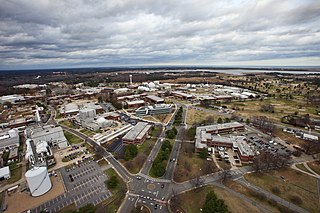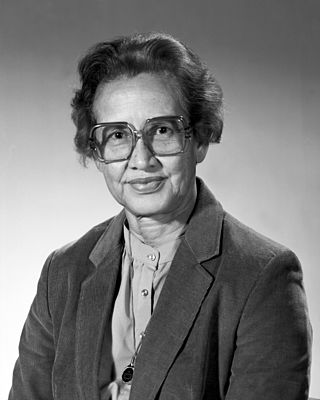Related Research Articles

Hampton is an independent city in Virginia, United States. As of the 2020 census, the population was 137,148. It is the 7th-most populous city in Virginia and 204th-most populous city in the nation. Hampton is included in the Hampton Roads metropolitan area, the 37th-largest in the United States, with a total population of 1,799,674 in 2020. This area, known as "America's First Region", also includes the independent cities of Chesapeake, Virginia Beach, Newport News, Norfolk, Portsmouth, and Suffolk, as well as other smaller cities, counties, and towns of Hampton Roads.

The Langley Research Center, located in Hampton, Virginia near the Chesapeake Bay front of Langley Air Force Base, is the oldest of NASA's field centers. LaRC has focused primarily on aeronautical research but has also tested space hardware such as the Apollo Lunar Module. In addition, many of the earliest high-profile space missions were planned and designed on-site. Langley was also considered a potential site for NASA's Manned Spacecraft Center prior to the eventual selection of Houston, Texas.

The term "computer", in use from the early 17th century, meant "one who computes": a person performing mathematical calculations, before electronic computers became commercially available. Alan Turing described the "human computer" as someone who is "supposed to be following fixed rules; he has no authority to deviate from them in any detail." Teams of people, often women from the late nineteenth century onwards, were used to undertake long and often tedious calculations; the work was divided so that this could be done in parallel. The same calculations were frequently performed independently by separate teams to check the correctness of the results.

Creola Katherine Johnson was an American mathematician whose calculations of orbital mechanics as a NASA employee were critical to the success of the first and subsequent U.S. crewed spaceflights. During her 33-year career at NASA and its predecessor, she earned a reputation for mastering complex manual calculations and helped pioneer the use of computers to perform the tasks. The space agency noted her "historical role as one of the first African-American women to work as a NASA scientist".

Christine Darden is an American mathematician, data analyst, and aeronautical engineer who devoted much of her 40-year career in aerodynamics at NASA to researching supersonic flight and sonic booms. She had an M.S. in mathematics and had been teaching at Virginia State University before starting to work at the Langley Research Center in 1967. She earned a Ph.D. in engineering at George Washington University in 1983 and has published numerous articles in her field. She was the first African-American woman at NASA's Langley Research Center to be promoted to the Senior Executive Service, the top rank in the federal civil service.
African-American women in computer science were among early pioneers in computing in the United States, and there are notable African-American women working in computer science.
The West Computers were the African American, female mathematicians who worked as human computers at the Langley Research Center of NACA from 1943 through 1958. These women were a subset of the hundreds of female mathematicians who began careers in aeronautical research during World War II. To offset the loss of manpower as men joined the war effort, many U.S. organizations began hiring, and actively recruiting, more women and minorities during the 1940s. In 1935, the Langley Research Center had five female human computers on staff. By 1946, the Langley Research Center had recruited about 400 female human computers.

Dorothy Jean Johnson Vaughan was an American mathematician and human computer who worked for the National Advisory Committee for Aeronautics (NACA), and NASA, at Langley Research Center in Hampton, Virginia. In 1949, she became acting supervisor of the West Area Computers, the first African-American woman to receive a promotion and supervise a group of staff at the center.

Hidden Figures is a 2016 American biographical drama film directed by Theodore Melfi and written by Melfi and Allison Schroeder. It is loosely based on the 2016 non-fiction book of the same name by Margot Lee Shetterly about three female African-American mathematicians: Katherine Goble Johnson, Dorothy Vaughan, and Mary Jackson, who worked at NASA during the Space Race. Other stars include Kevin Costner, Kirsten Dunst, Jim Parsons, Mahershala Ali, Aldis Hodge, and Glen Powell.

Margot Lee Shetterly is an American nonfiction writer who has also worked in investment banking and media startups. Her first book, Hidden Figures: The American Dream and the Untold Story of the Black Women Who Helped Win the Space Race (2016), is about African-American women mathematicians working at NASA who were instrumental to the success of the United States space program. She sold the movie rights while still working on the book, and it was adapted as a feature film of the same name, Hidden Figures (2016). For several years Shetterly and her husband lived and worked in Mexico, where they founded and published Inside Mexico, a magazine directed to English-speaking readers.

Mary Jackson was an American mathematician and aerospace engineer at the National Advisory Committee for Aeronautics (NACA), which in 1958 was succeeded by the National Aeronautics and Space Administration (NASA). She worked at Langley Research Center in Hampton, Virginia, for most of her career. She started as a computer at the segregated West Area Computing division in 1951. In 1958, after taking engineering classes, she became NASA's first black female engineer.

Hidden Figures: The American Dream and the Untold Story of the Black Women Who Helped Win the Space Race is a 2016 nonfiction book written by Margot Lee Shetterly. Shetterly started working on the book in 2010. The book takes place from the 1930s through the 1960s, depicting the particular barriers for Black women in science during this time, thereby providing a lesser-known history of NASA. The biographical text follows the lives of Katherine Johnson, Dorothy Vaughan, and Mary Jackson, three mathematicians who worked as computers at NACA and NASA, during the space race. They overcame discrimination there, as women and as African Americans. Also featured is Christine Darden, who was the first African-American woman to be promoted into the Senior Executive Service for her work in researching supersonic flight and sonic booms.
Doris Cohen was a twentieth-century American mathematician and aerodynamicist. She worked at the Langley Memorial Aeronautical Laboratory of the National Advisory Committee for Aeronautics. In 1941, a research report she published made her NACA's first female author.

Gladys Mae West is an American mathematician. She is known for her contributions to mathematical modeling of the shape of the Earth, and her work on the development of satellite geodesy models, that were later incorporated into the Global Positioning System (GPS). West was inducted into the United States Air Force Hall of Fame in 2018. West was awarded the Webby Lifetime Achievement Award for the development of satellite geodesy models.

Hidden Figures: The True Story of Four Black Women and the Space Race is a 2018 picture book by Margot Lee Shetterly with Winifred Conkling, illustrated by Laura Freeman. The picture book is adapted from Shetterly's 2016 non-fiction book Hidden Figures: The American Dream and the Untold Story of the Black Women Who Helped Win the Space Race. In 2019, it was spawned into a 15-minute animated film, narrated by Octavia Spencer and released by Weston Woods Studios.

Dorothy Estheryne McFadden Hoover was an American physicist and mathematician. Hoover was a pioneer in the early days of NASA. Originally one of the first black women hired at Langley as a human computer, Hoover would eventually become a published physicist and mathematician. Hoover is one of the first black women to be listed as a co-author on NASA research publications. Her research supported the development of America's first jet fighter, the Sabre. Hoover's accomplishments were featured in Margot Lee Shetterly's bestselling book, Hidden Figures.

The "Rocket Girls" were the women that worked at NASA and the Jet Propulsion Laboratory (JPL) before the development of desktop computers. These women are mostly unknown, but they did the majority of all hand calculations for missions. Most of these women were given the nickname of "computers" due to their abilities in the fields of physics and mathematics.

Virginia Layden Tucker was an American mathematician whose work at the National Advisory Committee for Aeronautics (NACA), the precursor to NASA, allowed engineers to design and improve upon airplanes. Tucker was one of the first human computers at the NACA, served as a recruiter for the program, and later worked as an aerodynamicist and an advocate for women in mathematics.

Miriam Daniel Mann (1907–1967) was one of the first Black female computers for the National Advisory Committee for Aeronautics (NACA).
Kathryn Peddrew was an African-American mathematician, engineer, and scientist who played a crucial role in the National Advisory Committee for Aeronautics (NACA) and the National Aeronautics and Space Administration (NASA). She was one of the African-American women who worked as a "human computer" at NACA's Langley Research Center in the 1940s and 1950s. Her work contributed significantly to advancements in aerospace technology and the United States' efforts in the space race. She is best known for her work as a researcher at the National Institutes of Health (NIH), where she played a crucial role in the development of treatments for diseases such as cancer and tuberculosis. Peddrew's work helped to break down racial and gender barriers in the scientific community and paved the way for future generations of minority scientists.
References
- 1 2 3 4 "Bonnie Land Obituary". Daily Press Obituaries. Archived from the original on 11 September 2023. Retrieved 9 October 2019.
- 1 2 3 "Virginia, Marriage Certificates, 1936-1988 - Virginia, Marriage Records, 1700-1850". FamilySearch.org. 10 January 2019. Retrieved 11 September 2023.
- 1 2 "Bonnie K Land - United States Social Security Death Index". FamilySearch.org. 21 January 2021. Retrieved 11 September 2023.
- ↑ "Human Computers". NasaCRgis. 23 April 2019. Archived from the original on 4 November 2019. Retrieved 9 October 2019.
- ↑ Fairfax, Colita Nichols (August 2005). Hampton, Virginia. Black America Series. Arcadia Publishing. p. 121. ISBN 0-7385-1810-7.
- 1 2 Head, Deirdre R. J. (August 2020). Dorothy Vaughan: NASA's Leading Human Computer. Capstone Press. p. 38. ISBN 978-1-4966-8819-4.
- 1 2 3 "Hidden no more: The African-American women of NASA's history". Silicon Republic. 24 February 2017. Archived from the original on 31 March 2023. Retrieved 9 October 2019.
- 1 2 Shetterly, Margot Lee (7 February 2017). "Hidden figures: the history of Nasa's black female scientists". The Observer. ISSN 0029-7712. Archived from the original on 9 October 2019. Retrieved 9 October 2019.